
(a)
Interpretation:
The synthesis of polyoxetane via anionic
Concept introduction:
Oxetane is a four membered ether ring and is highly strained. Anionic polymerization is a type of chain growth polymerization in which polymerization is initiated by anions. In the propagation step, the reactive intermediates are anions and not free radicals. Termination occurs in anionic polymerization when an acid is added to the reaction mixture. The anion is neutralized in the resulting proton transfer, which ends the propagation cycle. The anionic polymerization mechanism is an
Answer to Problem 26.44P
The oxetane is a four membered ether ring and is highly strained. It can undergo anionic ring-opening polymerization to relieve the strain. The anionic polymerization is initiated by an oxide ion which acts as a nucleophile. This is an
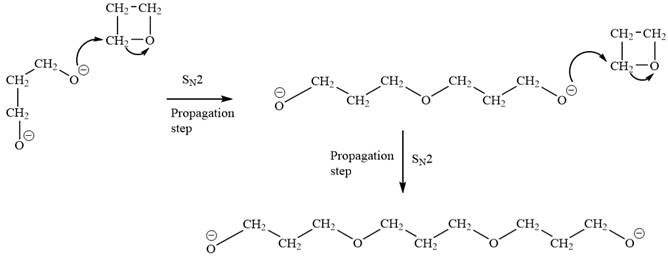
Explanation of Solution
The structure of oxetane is as below:

The oxetane is a four membered ether ring and is highly strained. It can undergo anionic ring-opening polymerization to relieve the strain. The anionic polymerization is initiated by an oxide ion which acts as a nucleophile. This is an
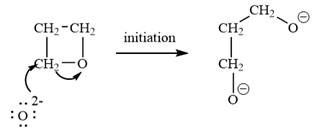
The oxygen atom of oxetane gains a negative charge and thus acts as a nucleophile. This acts as a site of chain growth. The propagation step can be shown as below:
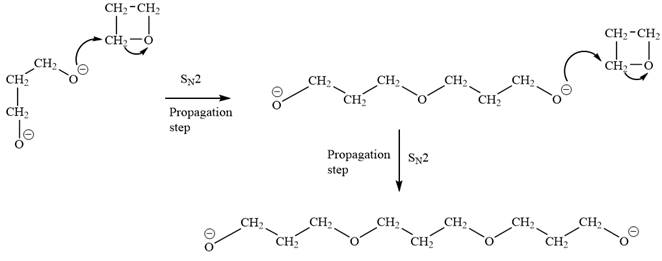
The anionic polymerization mechanism is an
(b)
Interpretation:
The condensed formula for polyoxetane is to be drawn.
Concept introduction:
In a condensed formula, each nonhydrogen atom is written explicitly, followed immediately by the number of hydrogen atoms that are bonded to it. Adjacent nonhydrogen atoms in the condensed formula are interpreted as being covalently bonded to each other. Parentheses in a condensed formula denote that the group is attached to the previous C. Lone pairs are not shown explicitly in the condensed formula.
Answer to Problem 26.44P
The condensed formula for polyoxetane is

Explanation of Solution
The structure of oxetane is as below:

The oxetane is a four membered ether ring and is highly strained. It can undergo anionic ring-opening polymerization to relieve the strain. The anionic polymerization is initiated by an oxide ion which acts as a nucleophile. This is an
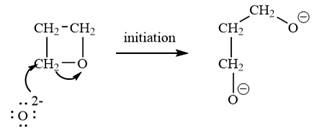
In a condensed formula, each nonhydrogen atom is written explicitly, followed immediately by the number of hydrogen atoms that are bonded to it. Adjacent nonhydrogen atoms in the condensed formula are interpreted as being covalently bonded to each other. Parentheses in a condensed formula denote that the group is attached to the previous C. Lone pairs are not shown explicitly in the condensed formula. Thus, the condensed formula of oxetane is:

In a condensed formula, each nonhydrogen atom is written explicitly, followed immediately by the number of hydrogen atoms that are bonded to it.
(c)
Interpretation:
It is to be determined if polyoxetane is expected to be more or less soluble in water than poly(ethelene oxide).
Concept introduction:
The solubility of a
Answer to Problem 26.44P
Polyoxetane (PO) is expected to be less soluble in water than poly(ethelene oxide) (PEO), as the extent of hydrogen bonding is less along the chain of polyoxetane than in polyethelene oxide.
Explanation of Solution
The condensed structures of polyoxetane and poly(ethelene oxide) are shown below:
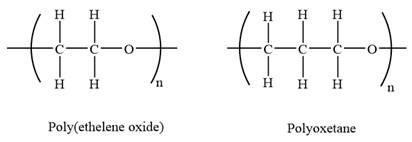
The repeating units in both are shown in the parenthesis. Poly(ethelene oxide) has two carbon atoms while polyoxetane has three carbon atoms in the repeating unit. As the number of carbon atoms increases the solubility of the polymer decreases. Both the repeating units have an oxygen atom in it. Due to which hydrogen bonding is possible. The number of carbon atoms in polyoxetane is more so, oxygen occurs less frequently in polymer chain in than in polyethelene oxide. As a result, there will be less hydrogen bonding with water along the chain of polyoxetane than in polyethelene oxide. Hence, it is expected that polyoxetane (PO) will be less soluble in water than poly(ethelene oxide) (PEO).
As the strength of intermolecular forces increases, the solubility of a polymer in a given solvent increase.
(d)
Interpretation:
It is to be determined if polyoxetane is expected to have a higher or lower melting point than poly(ethelene oxide).
Concept introduction:
The melting point of a polymer depends on the strength of intermolecular forces present in that particular polymer. Among two polymers, a more polar polymer has stronger intermolecular forces than a less polar polymer. The polarity depends on the asymmetric distribution of electrons and the presence of electronegative atoms. Hydrogen bonding is the strongest intermolecular force present in covalent compounds.
Answer to Problem 26.44P
Polyoxetane (PO) is expected to have a lower melting point than poly(ethelene oxide) (PEO), as the extent of hydrogen bonding is less along the chain of polyoxetane than in polyethelene oxide. Also, as the number of carbon atoms in poyoxetane is more, it is slightly less polar than polyethelene oxide.
Explanation of Solution
The condensed structures of polyoxetane and poly(ethelene oxide) are shown below:

The repeating units in both are shown in the parenthesis. Poly(ethelene oxide) has two carbon atoms while polyoxetane has three carbon atoms in the repeating unit. As the number of carbon atoms increases the polarity decreases. Polyoxetane is slightly less polar than polyethelene oxide.
Both the repeating units have an oxygen atom in it. Due to which hydrogen bonding is possible. The number of carbon atoms in polyoxetane is more so, oxygen occurs less frequently in polymer chain in than in polyethelene oxide. As a result, there will be less hydrogen bonding. Hence, polyoxetane (PO) is expected to have a lower melting point than poly(ethelene oxide) (PEO).
As the strength of intermolecular forces increases, the melting point increase.
Want to see more full solutions like this?
Chapter 26 Solutions
EBK GET READY FOR ORGANIC CHEMISTRY
- CH, CH CH₂ CH₂ Phytyl side chain 5. What is the expected order of elution of compounds A-D below from a chromatography column packed with silica gel, eluting with hexane/ethyl acetate? C D OHarrow_forwardPlease analze my gel electrophoresis column of the VRK1 kinase (MW: 39.71 kDa). Attached is the following image for the order of column wells and my gel.arrow_forward2.0arrow_forward
- Write the electron configuration of an atom of the element highlighted in this outline of the Periodic Table: 1 23 4 5 6 7 He Ne Ar Kr Xe Rn Hint: you do not need to know the name or symbol of the highlighted element! ☐arrow_forwardCompare these chromatograms of three anti-psychotic drugs done by HPLC and SFC. Why is there the difference in separation time for SFC versus HPLC? Hint, use the Van Deemter plot as a guide in answering this question. Why, fundamentally, would you expect a faster separation for SFC than HPLC, in general?arrow_forwardA certain inorganic cation has an electrophoretic mobility of 5.27 x 10-4 cm2s-1V-1. The same ion has a diffusion coefficient of 9.5 x 10-6cm2s-1. If this ion is separated from cations by CZE with a 75cm capillary, what is the expected plate count, N, at an applied voltage of 15.0kV? Under these separation conditions, the electroosmotic flow rate was 0.85mm s-1 toward the cathode. If the detector was 50.0cm from the injection end of the capillary, how long would it take in minutes for the analyte cation to reach the detector after the field was applied?arrow_forward
- 2.arrow_forwardPlease solve for the following Electrochemistry that occursarrow_forwardCommercial bleach contains either chlorine or oxygen as an active ingredient. A commercial oxygenated bleach is much safer to handle and less likely to ruin your clothes. It is possible to determine the amount of active ingredient in an oxygenated bleach product by performing a redox titration. The balance reaction for such a titration is: 6H+ +5H2O2 +2MnO4- à 5O2 + 2Mn2+ + 8H2O If you performed the following procedure: “First, dilute the Seventh Generation Non-Chlorine Bleach by pipetting 10 mL of bleach in a 100 mL volumetric flask and filling the flask to the mark with distilled water. Next, pipet 10 mL of the diluted bleach solution into a 250 mL Erlenmeyer flask and add 20 mL of 1.0 M H2SO4 to the flask. This solution should be titrated with 0.0100 M KMnO4 solution.” It took 18.47mL of the KMnO4 to reach the endpoint on average. What was the concentration of H2O2 in the original bleach solution in weight % assuming the density of bleach is 1g/mL?arrow_forward
- 10.arrow_forwardProper care of pH electrodes: Why can you not store a pH electrode in distilled water? What must you instead store it in? Why?arrow_forwardWrite the electron configuration of an atom of the element highlighted in this outline of the Periodic Table: 1 23 4 569 7 He Ne Ar Kr Xe Rn Hint: you do not need to know the name or symbol of the highlighted element! §arrow_forward
 ChemistryChemistryISBN:9781305957404Author:Steven S. Zumdahl, Susan A. Zumdahl, Donald J. DeCostePublisher:Cengage Learning
ChemistryChemistryISBN:9781305957404Author:Steven S. Zumdahl, Susan A. Zumdahl, Donald J. DeCostePublisher:Cengage Learning ChemistryChemistryISBN:9781259911156Author:Raymond Chang Dr., Jason Overby ProfessorPublisher:McGraw-Hill Education
ChemistryChemistryISBN:9781259911156Author:Raymond Chang Dr., Jason Overby ProfessorPublisher:McGraw-Hill Education Principles of Instrumental AnalysisChemistryISBN:9781305577213Author:Douglas A. Skoog, F. James Holler, Stanley R. CrouchPublisher:Cengage Learning
Principles of Instrumental AnalysisChemistryISBN:9781305577213Author:Douglas A. Skoog, F. James Holler, Stanley R. CrouchPublisher:Cengage Learning Organic ChemistryChemistryISBN:9780078021558Author:Janice Gorzynski Smith Dr.Publisher:McGraw-Hill Education
Organic ChemistryChemistryISBN:9780078021558Author:Janice Gorzynski Smith Dr.Publisher:McGraw-Hill Education Chemistry: Principles and ReactionsChemistryISBN:9781305079373Author:William L. Masterton, Cecile N. HurleyPublisher:Cengage Learning
Chemistry: Principles and ReactionsChemistryISBN:9781305079373Author:William L. Masterton, Cecile N. HurleyPublisher:Cengage Learning Elementary Principles of Chemical Processes, Bind...ChemistryISBN:9781118431221Author:Richard M. Felder, Ronald W. Rousseau, Lisa G. BullardPublisher:WILEY
Elementary Principles of Chemical Processes, Bind...ChemistryISBN:9781118431221Author:Richard M. Felder, Ronald W. Rousseau, Lisa G. BullardPublisher:WILEY





